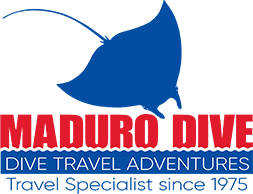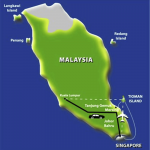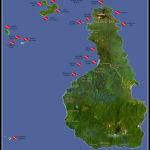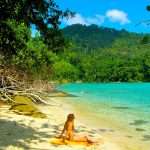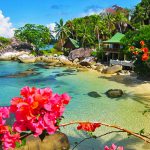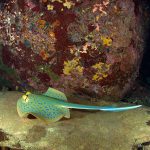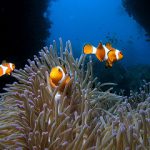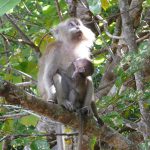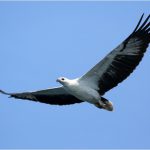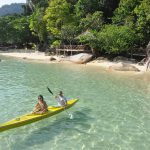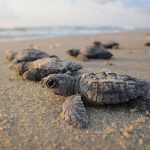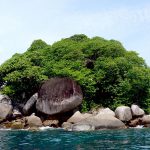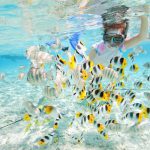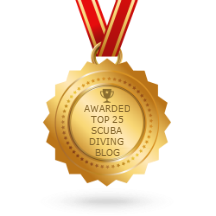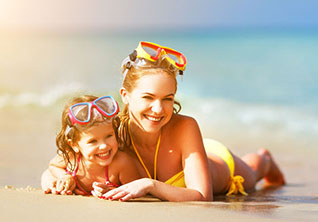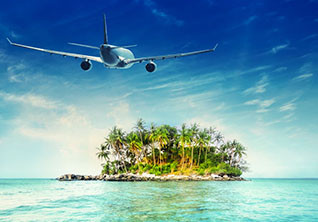Tioman Islands, Malaysia
The Most Unconsciously Recognizable Islands In The World
Going to Tioman Islands, Malaysia to go scuba diving can require flying some 16 hours to get to Singapore, then a vehicle on a five hour drive over to Mersing on the west coast of Malaysia, then a two hour ferry ride over to the Tioman Islands. Happily, you will then arrive at one of the most tranquil dive destinations in the world. You’ll find white sand beaches, tropical jungles, and waterfalls, and even though you have never been here before, some of the local sites and locations may appear eerily familiar to you; especially if you like musicals. You see, the Tioman Islands may have been visited by passing Chinese merchant and fishing vessels for the past several thousand years, but when Hollywood chose Pulau Tioman for the location of the movie “South Pacific” in 1958, then the Tioman Islands were not only put on the proverbial map, but the pristine beaches were highlighted worldwide on the big screen and currently on DVD; a must see before you dive the Tioman Islands.
We could go on and mention that Time Magazine in the 1970’s chose Tioman as one of the world’s most beautiful islands, but as divers, we have to search deeper for what makes an aquatic destination a worthwhile vacation. To start with, out here you can take almost every dive site for granite: literally; unless it’s a wreck dive. It appears that granite boulders of all sorts of sizes make up the majority of the dive sites, and this has given hard corals and soft corals alike, a good foundation to grow upon for thousands of years. Where the corals haven’t been able to grow, swim throughs, caverns, and over hangs give refuge to large schools of fish or resting sites for white tip sharks, peacock stingrays, turtles, cuttlefish, octopus, lobsters, and moray eels. To ensure that these scuba diving underwater sites would remain prolific and protected for posterity, eight Islands in addition to Tioman Islands, Malaysia have been designated as marine parks and reserves. They did the same thing with the rainforests, so that binturongs, long tail macaque, slow loris, palm civets and 41 other mammals, 138 species of birds, the walking catfish, and the endemic Kajang slender litter frog would be protected as well. So you can see that just like the mythical Island of Bali Hai, Pulau; Tioman is a beautiful island with lots of underwater life and forest life left in its natural state.
As far as the dive sites go, there are some 30 sites around Tioman Island and the outer islands that make up the marine park. One of the top requested dive sites is Tiger Reef. This submerged pinnacle is between Golden Reef and Labas Island, and practically straight east of Renggis Island. Tiger Reef is in a channel and the top of the pinnacle is 10m (30ft) underwater and bottoming out at 22m (66ft). Here soft corals, hard corals, and barrel sponges brilliant in all colors try to desperately hold your attention, but fail in comparison to the multitudes of fish passing by or residing in the coral. Small damsels and clown fish to angle fish, batfish, yellowfin tuna, barracuda, white tip and black tip sharks, and even occasional whale sharks can be seen passing by. The currents can be strong here and advanced diver rating is required to dive this site. Another popular dive for pure abundance of sea life is nearby Golden Reef where you can find stingrays, moray eels, and nurse sharks, and of course Magician Rock seems to have everything, but diving here can be occasionally restricted due to strong currents. If you are in to caves, caverns, and tunnels, then Labas Island is a must dive. Take granite boulders and collect them to resemble a sponge or piece of Swiss cheese, and you get the visual. Corals and nudibranchs line the walls, and glassfish, butterfly fish, eels, and turtles act as reluctant guides as you pass by their homesteads. Batu Malang or Coral Island has several dive sites including Fan Canyon where you are allowed to swim around and see large fan corals precariously positioned on the side of the V canyon formation. You aren’t allowed to swim through it though, for the long term safety of the fragile corals, but you can try and count the varieties of nudibranchs, and then swim through a tunnel down at 16m (48ft), and have your dive gear inspected by thousands of anchovies and even cleaned by a few colorful wrasses. Coral Island also has two bays to explore with Kador Bay to explore for lobster, stonefish, and turtles on the east side of the island and on the west side of the island we find One Tree Bay, home to Spanish mackerels, bumphead parrot fish, and/or napoleon wrasse to name a few. The potato coral found around Coral Island are a favorite location for cuttlefish to attach their eggs. Off the island of Chebeh Island there are a few good sites to view walls, tunnels, swim throughs and a large cavern with tons of coral structures including black corals, bat fish, turtles, cuttlefish, trevallies, reef sharks, yellowtail fusiliers, yellowtail barracudas, yellow snapper, and more. Now if you get tired of yellow fish, then you have to go up to North Point and view the black tip reef sharks, black surgeon fish, and orange striped triggerfish; among a cast of many other colorful fish.
If you are into wreck dives, over by Soyak Island are the 31m (93ft) long KM Sipadan, (a former Royal navy ship sunk in 2005), and Sawadee (two former Thai fishing boat) wrecks. They are all tied together, easy to find, and covered with soft, corals, some hard corals, and lots of assorted fish, turtles, and one large notable grouper. If you are into tech diving, there are two WWII wrecks close by. The battlecruiser HMS Repulse rests at 56m (183ft) and the battleship HMS Prince of Whales is at 68m (223ft). Without air support, they were both sunk by Imperial Japanese long range torpedo bombers. Both upside-down wrecks are considered to be British Royal Navy property, but after the end of the war they have since been heavily damaged by explosives of scrap metal dealers.
As for night dives, may we recommend one of the several house reefs depending on where you stay, The Salang village jetty, or a boat dive off of Renggis or Soyak Island.
For things to do when not diving. Sure Tioman Islands, Malaysia has plenty of beautiful sunsets and more than its fare share of enchanted evenings, but if you are looking for night life, dance halls, party boats, and casinos, then this is not the void you are looking for. You can hike three different waterfalls, like Asah waterfall featured in South Pacific or perhaps rest on a beach such as Paya or Monkey Beach. There is also plenty of snorkeling, kayaking, canoeing, and windsurfing. The Tioman Islands are all about chilling out and relaxing; or chilaxing if you will. Sure, you can help with the turtle hatchings at the TAT (Tengku Arif Temenggung) Turtle Sanctuary in Tekek Village or at the Juara Turtle Project (JTP) in Juara village between March and October, but most of the other times of year, listening to forest creatures, the sound of water, wind, and watching the sun set are the main land attractions; that is unless you come upon a beach where a cast of fevered tourists are singing a musical passage from South Pacific.
As for the local cuisine, food groups include Thai, Chinese, and Malaysian dishes, with multiple places offering BBQ’d fresh seafood. And for those homesick for the Big Apple, there is at least one place where you can get a freshly made Island style pizza.
The best time to visit is between February to November with February thru March being Pharaoh Reef cuttlefish mating season; and who in their right mind wouldn’t want to view this natural seductively romantic exhibition that’s almost as old as time itself?
The local language is Malay (Bahasa Melayu), but you’ll also find plenty English spoken many places. Currency is 240 volts, so you may need to bring a converter. Vis is 15m-30m depending on the time of year and site. A 3ml shorty wetsuit works well for most divers and snorkelers. Rental gear is available at several local dive shops. Sightings of frogfish, sea horses, or whale sharks are not guaranteed, but experienced local tour guides can help you discover these potentially scenic and sometimes enchanted moments too.
